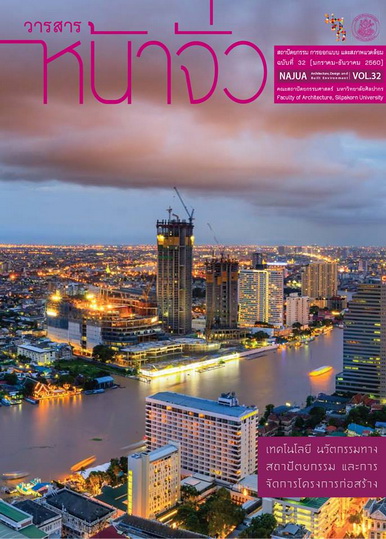เคลื่อนไหวเพื่อเข้าใจพื้นที่ทางสถาปัตยกรรม
Keywords:
การเคลื่อนไหวร่างกาย, การรับรู้, ปรากฏการณ์ทางสถาปัตยกรรม, กระบวนการการรับรู้-การเคลื่อนไหว, Body in movement, Architectural Phenomena, Sensory-motor phenomenaAbstract
บทความนี้มีวัตถุประสงค์ในการตั้งคำถามถึงบทบาทและหน้าที่ของร่างกายมนุษย์ที่มีความสัมพันธ์กับพื้นที่ทางสถาปัตยกรรม เนื่องจากร่างกายของมนุษย์ถูกใช้เป็นเครื่องมือในการออกแบบงานสถาปัตยกรรมมาอย่างต่อเนื่อง โดยการใช้สัดส่วนของร่างกายมนุษย์เพื่อกำหนดขนาดและมิติขององค์ประกอบต่างๆ ของพื้นที่ทางสถาปัตยกรรม ทั้งที่ในความเป็นจริงแล้วร่างกายของมนุษย์ประกอบไปด้วยปัจจัยภายนอกและปัจจัยภายในที่มีความสัมพันธ์กันและทำงานร่วมกันอยู่ตลอดเวลา ปัจจัยภายนอกคือ “ร่างกาย” ซึ่งถูกนำมาใช้เป็นข้อมูลในการออกแบบพื้นที่เสมอมา ส่วนปัจจัยภายในนั้นคือ “การรับรู้” ซึ่งยังไม่ค่อยถูกนำมาอ้างอิงในการออกแบบพื้นที่อย่างเป็นรูปธรรม โดยที่ระบบการทำงานของทั้งสองปัจจัยนี้ถูกขับเคลื่อนผ่านการเคลื่อนไหวของร่างกาย และแสดงออกผ่านพฤติกรรมการใช้งานพื้นที่ทั้งที่เป็นกิจกรรมการใช้งานทางร่างกายและกิจกรรมการใช้งานทางการรับรู้
ดังนั้น การเคลื่อนไหวของร่างกายมนุษย์จึงสามารถสะท้อนถึงคุณภาพของพื้นที่ และประสบการณ์ที่เกิดขึ้นบนพื้นที่ได้ โดยเป็นรูปแบบของการทำความเข้าใจกับปรากฏการณ์ที่ถูกแสดงออกมาบนพื้นที่ทางสถาปัตยกรรมในช่วงเวลาใดเวลาหนึ่ง
Motion in Experiencing Architecture
Sarawut Preamechai
Faculty of Architecture, Silpakorn University
The objective of this article is to interrogate on the relationship between architectural space and human body. Relatively, the human body is always taken as an important tool in the architectural design process, especially on the notion of anthropomorphic proportion as an essential reference to identify size and dimension of various elements in architectural space. Substantially, the human body is equipped with the relationships between internal and external factors. These two active factors are inseparably unified. The external factor could declare the body in term of its physical sense. On the other hand, the internal one could, then, declare the body in term of its sense of perception. The later one to which has hardly established in the architectural design process. The two active factors always conduct the movement of human physical body. These two factors have also been demonstrated through the space uses in both activated and perceivable sense of space. Therefore, the corporal mobility could validate qualification of space and the way in which space is experienced. These speculated extent would be demonstrated through specified architectural space within its particular temporal dimension.





